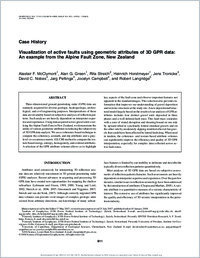Visualization of active faults using geometric attributes of 3D GPR data: An example from the Alpine Fault Zone, New Zealand
- McClymont, Alastair F. GNS Science, Lower Hutt, New Zealand. .
- Green, Alan G. GNS Science, Lower Hutt, New Zealand. .
- Streich, Rita GNS Science, Lower Hutt, New Zealand. .
- Horstmeyer, Heinrich GNS Science, Lower Hutt, New Zealand. .
- Tronicke, Jens GNS Science, Lower Hutt, New Zealand. .
- Nobes, David C. GNS Science, Lower Hutt, New Zealand. .
- Pettinga, Jarg GNS Science, Lower Hutt, New Zealand. .
- Campbell, Jocelyn GNS Science, Lower Hutt, New Zealand. .
- Langridge, Robert GNS Science, Lower Hutt, New Zealand. .
Published in:
- GEOPHYSICS. - Society of Exploration Geophysicists. - 2008, vol. 73, no. 2, p. B11-B23
English
Three-dimensional ground-penetrating radar (GPR) data are routinely acquired for diverse geologic, hydrogeologic, archeological, and civil engineering purposes. Interpretations of these data are invariably based on subjective analyses of reflection patterns. Such analyses are heavily dependent on interpreter expertise and experience. Using data acquired across gravel units overlying the Alpine Fault Zone in New Zealand, we demonstrate the utility of various geometric attributes in reducing the subjectivity of 3D GPR data analysis. We use a coherence-based technique to compute the coherency, azimuth, and dip attributes and a gray-level co-occurrence matrix (GLCM) method to compute the texture-based energy, entropy, homogeneity, and contrast attributes. A selection of the GPR attribute volumes allows us to highlightkey aspects of the fault zone and observe important features not apparent in the standard images. This selection also provides information that improves our understanding of gravel deposition and tectonic structures at the study site. A new depositional/structural model largely based on the results of our analysis of GPR attributes includes four distinct gravel units deposited in three phases and a well-defined fault trace. This fault trace coincides with a zone of stratal disruption and shearing bound on one side by upward-tilted to synclinally folded stratified gravels and on the other side by moderately dipping stratified alluvial-fan gravels that could have been affected by lateral fault drag. When used in tandem, the coherence- and texture-based attribute volumes can significantly improve the efficiency and quality of 3D GPR interpretation, especially for complex data collected across active fault zones.
- Language
-
- English
- Open access status
- green
- Identifiers
-
- DOI 10.1190/1.2825408
- ISSN 0016-8033
- Persistent URL
- https://folia.unifr.ch/global/documents/209531
Statistics
Document views: 17
File downloads:
- fulltext.pdf: 0
